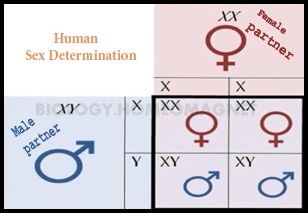What are sex chromosomes?
In organisms where two sexes are distinct, certain chromosomes (usually one or two) in a diploid cell differ from the rest in staining reaction and behaviour during cell division. These chromosomes determine the sex of an individual and are thus called sex chromosomes . The rest of the chromosomes are said to be autosomes. In a diploid individual, there are 2n-2 autosomes and two sex chromosomes.
What is X and Y chromosomes?
In certain insects like grasshoppers and roundworms females have two sex or X-chromosomes while males have only one, and thus females are designated XX and males XO. In humans and other mammals, most insects (e.g., Drosophila) and many plants (e.g., Coccinia, Melandrium), females have two X-chromosomes (XX), whereas males have one X and a morphologically distinct Y-chromosome (XY). Y-chromosome, though different in size and shape, pairs with X during meiosis. Thus females are XX and males are XY. Since, males produce two types of gametes, X or O in XO type and X or Y in XY type, they are said to be heterogametic Females are homogametic, producing only one type of gamete with an X-chromosome.
However, in birds and some reptiles, females are heterogametic while males are homogametic. To avoid confusion with the male heterogametic X and Y chromosomes system, this is referred to WZ system; with males WW and females WZ .
X and Y chromosomes and Sex determination
Sex determination is concerned with the study of factors which are responsible for making an individual male, female or a hermaphrodite. Since long, both biologists and non- biologists are puzzled by the riddle that what determines the sex of an offspring. Numerous mistaken hypothesis and wild guesses were put forward but a valid solution became possible only with the discovery of sex chromosomes in the early years of the 20th century. Latter it has been suggested that the Sex determination is dependent on X and Y chromosomes.
X and Y chromosomes Theory of Sex Determination
Acording to the chromosomal theory of sex determination, two types of chromosomes, i.e. autosomes and sex-chromosomes are present in each individual, and the male and female individuals differ in their
sex-chromosome constitution. In many animals and in some dioecious plants, a heteromorphic pair of chromosomes has been identified responsible for sex determination. In Drosophila, for example, the female has two X-chromosomes (XX), whereas the male (XY) has one X-chromosome and another morphologically distinct Y-chromosome. Man has 23 pairs of chromosomes with 22 alike homologues and one heteromorphic pair associated with sex determination.
In plants also, the sex is mainly controlled by the Y-chromosome. If Y-chromosome is present, it is male and if Y-chromosome is absent, it is female.
Balance Theory of X and Y Chromosomes for Sex Determination
The balance theory of sex determination, proposed by C.B. Bridges (1925), states that the presence or absence of the Y-sex chromosome is not the sex determining factor but it is the balance of the number of X and Y chromosomes and the number of sets of autosomes present which determines the sex of an offspring,
He accidentally obtained a triploid (3n) Drosophila (with three X-chromosomes and three set of autosomes, 3A + XXX). He crossed the triploid (3n) female with a normal male (2A + XY) and secured a number of interesting individuals, which differed in the number of X-chromosomes and the number of sets of autosomes. The results of Bridges' experiment are presented in Table 1, with the ratio of X-chromosomes to autosomes. In a normal female with two X-chromosomes and two sets of autosomes the ratio of X-chromosomes to autosomes is one. In a normal male the ratio of X-chromosomes to autosomes is 0.5 since there is only one X-chromosome for two sets of autosomes.
Intersexes are sterile flies intermediate between males and females, while gynandromorphs have part of the body female and the part male.
Biology Related Pages:
- Biology
- Branches of Biology
- Biological classification
- Origin of Life
- Biochemical Origin of Life
- Smallest unit of Life
- Types of Cells
- Eukaryotic Cells
- Cell Cytoplasm
- Golgi body
- Mitochondria
- Function of Endoplasmic Reticulum
- Ribosome Structure
- Lysosomes
- Microtubules
- Cell Wall
- Cell Nucleus
- Cell Nucleus Structure
- Chromosomes
- Chromosome Structure
- DNA Replication
- X and Y Chromosomes
- Cell Membrane
- Cell Junctions
- Cell Division
- Amitosis
- Mitosis
- Meiosis
- Meiosis Stages
- Respiration
- Cellular Respiration
- Process of Respiration
- Digestion
- Genetics
- Gene
- Mendel’s Experiments
- Natural Selection
- The Law of Segregation
- Genetic Variation
- Crossing Over
- Gene Mapping
- Transgenic Plants
- Mutation
- Gene Mutation
- Chromosomal Mutations
- Ecological Community
- Ecosystem
- Structure of ecosystem
- Sweat Glands
- Causes of overpopulation
- Effects of overpopulation
- Population Control
- Air Pollution


